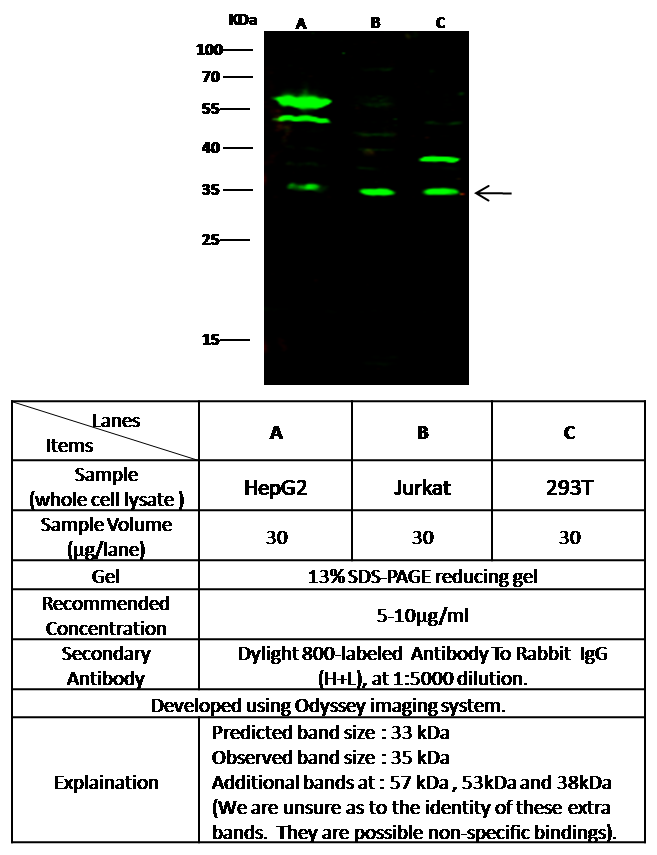-
Product Name
Anti-TIM-3/HAVCR2 antibody
- Documents
-
Description
Rabbit polyclonal to TIM-3/HAVCR2
-
Tested applications
ELISA, WB, IP
-
Species reactivity
Mouse TIM-3 / HAVCR2
-
Alternative names
FLJ14428 antibody; HAVCR2 antibody; HAVCR2 antibody; KIM-3 antibody; MGC124149 antibody; MGC124150 antibody; RP23-248K2.7 antibody; Tim3 antibody; TIM3 antibody; TIM-3 antibody; Tim-3 antibody; Timd3 antibody; TIMD3 antibody; TIM3 antibody; KIM-3 antibody; TIMD3 antibody; Tim-3 antibody; TIMD-3 antibody; HAVcr-2 antibody; Tim3 antibody; TIM-3 antibody; Timd3 antibody
- Immunogen
-
Isotype
Rabbit IgG
-
Preparation
Produced in rabbits immunized with purified, recombinant Mouse TIM-3 / HAVCR2 (rh TIM-3 / HAVCR2 ; AAL65156.1; Met1-Arg191). TIM-3 / HAVCR2 specific IgG was purified by Mouse TIM-3 / HAVCR2 affinity chromatography.
-
Clonality
Polyclonal
-
Formulation
0.2 μm filtered solution in PBS
-
Storage instructions
This antibody can be stored at 2℃-8℃ for one month without detectable loss of activity. Antibody products are stable for twelve months from date of receipt when stored at -20℃ to -80℃. Preservative-Free.
Sodium azide is recommended to avoid contamination (final concentration 0.05%-0.1%). It is toxic to cells and should be disposed of properly. Avoid repeated freeze-thaw cycles. -
Applications
WB: 5-10 μg/mL
ELISA: 0.1-0.2 μg/mL
This antibody can be used at 0.1-0.2 μg/mL with the appropriate secondary reagents to detect Mouse TIM-3 / HAVCR2. The detection limit for Mouse TIM-3 / HAVCR2 is < 0.039 ng/well.
IP: 1-4 μg/mg of lysate
-
Validations

TIM-3 / HAVCR2 Antibody, Rabbit PAb, Antigen Affinity Purified, Immunoprecipitation

TIM-3 / HAVCR2 Antibody, Rabbit PAb, Antigen Affinity Purified, Western blot
-
Background
Hepatitis A virus cellular receptor 2 (HAVCR2), formerly known as T cell immunoglobulin and mucin domain-3 (TIM-3), is a transmembrane glycoprotein expressed on the surface of terminally differentiated Th1 cells but not on Th2 cells. It was the first surface molecule that specifically identifies Th1 cells in both mice and human. Recently, identification of Galectin-9 as a ligand for TIM-3 has established the TIM-3-Galectin-9 pathway as an important regulator of Th1 immunity and tolerance induction. Engagement of Tim-3 by its ligand galectin-9 negatively regulates IFN-gamma secretion and influences the ability to induce T cell tolerance in both mice and man. It suggests a novel paradigm in which dysregulation of the TIM-3-galectin-9 pathway could underlie chronic autoimmune disease states, such as multiple sclerosis. Recent work has explored the role of TIM-3 in systemic lupus erythematosus (SLE), and their results indicate that TIM-3 may represent a novel target for the treatment of SLE. Numerous studies have demonstrated that Tim-3 influences autoimmune diseases, including diabetes and multiple sclerosis, and its role in other inflammatory diseases including allergies and cancer is beginning to become clear. In tumor rejection model, soluble form of Tim-3 (sTim-3) significantly impaired T cell antitumor immunity, evidenced by decreased antitumor CTL activity and reduced amount of tumor-infiltrating lymphocytes in tumor. sTim-3 as an immunoregulatory molecule that may be involved in the negative regulation of T cell-mediated immune response.
-
References
- Geng H, et al. (2006) Soluble form of T cell Ig mucin 3 is an inhibitory molecule in T cell-mediated immune response. J Immunol. 176(3): 1411-20.
- Anderson AC, et al. (2006) TIM-3 in autoimmunity. Curr Opin Immunol. 18(6): 665-9.
- Anderson DE. (2007) TIM-3 as a therapeutic target in human inflammatory diseases. Expert Opin Ther Targets. 11(8): 1005-9.
- Pan HF, et al. (2010) TIM-3 as a new therapeutic target in systemic lupus erythematosus. Mol Biol Rep. 37(1): 395-8.
Related Products / Services
Please note: All products are "FOR RESEARCH USE ONLY AND ARE NOT INTENDED FOR DIAGNOSTIC OR THERAPEUTIC USE"
